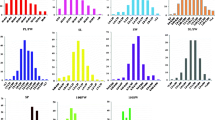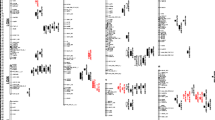Abstract
It is important to evaluate yield and agronomic traits when selecting for elite lines in Brassica napus L. In this study, 488 global collections of B. napus L. were evaluated for yield and agronomic traits during two consecutive years under growing conditions in central China. A series of phenotypic data for yield and agronomic traits were obtained. Large variations in yield and agronomic traits were found among these accessions, making selection possible for these characters. Chinese accessions, in general, tended to have higher plot yield (POY), higher seed yield per plant (PY), higher thousand-seed weight (TSW), more seeds per silique (SS), and fewer siliques per plant (PS) than foreign accessions. Comparing winter, semi-winter, and spring accessions, semi-winter accessions tended to have the highest POY, highest PY, highest TSW, most SS and fewest PS. Genotypic variation for TSW accounted for 71.23 % of the total variation, and it was the highest for all 12 of the phenotypic traits. Significant correlations were observed between different traits. Principal component analysis (PCA) revealed that significant variation among the traits with the first four principal components could explain 49.8 % of the total variation. Three major groups (winter, spring and semi-winter oilseed rape accessions) could be distinguished when projecting the accessions onto the first two PCAs. The information on variations in yield and agronomic traits detected in this study provided useful parents for rapeseed breeding. Moreover, the phenotypic data on yield and agronomic traits obtained may be used in our subsequent genome-wide association studies for B. napus.



Similar content being viewed by others
References
Algan N, Aygün H (2001) Correlation between yield and yield components in some winter rape genotypes (in Turkish). J Ege Uni Agric Faculty 38(1):9–15
Ana MJ, Ankica KS, Dejana SP, Radovan M, Nikola H (2009) Phenotypic and molecular evaluation of genetic diversity of rapeseed (Brassica napus L.) genotypes. Afr J Biotechnol 8(19):4835–4844
Becker HC, Engqvist GM, Karlsson B (1995) Comparison of rapeseed cultivars and resynthesized lines based on allozyme and RFLP markers. Theor Appl Genet 91:62–67
Bus A, Korber N, Snowdon RJ, Stich B (2011) Patterns of molecular variation in a species-wide germplasm set of Brassica napus. Theor Appl Genet 123:1413–1423
Diers BW, Osborn TC (1994) Genetic diversity of oilseed Brassica napus germplasm based on restriction fragment length polymorphisms. Theor Appl Genet 88:662–668
Fisher RA (1924) The distribution of the partial correlation coefficient. Metron 3:329–332
Friedt W, Snowdon RJ (2009) Oilseed rape. In: Vollmann J, Rajcan I (eds) Handbook of plant breeding. Oil crops, vol 4. Springer, New York, pp 91–126
Gai JY (2000) Experimentation method. China Agriculture Press, Beijing China
Gepts P, Papa R (2003) Possible effects of (trans) gene flow from crops on the genetic diversity from landraces and wild relatives. Environ Biosafety Res 2:89–103
Gunasekera CP, Martin LD, Siddique KHM, Walton GH (2006) Genotype by environment interactions of Indian mustard (Brassica juncea L.) and canola (B. napus L.) in Mediterranean-type environments. I. Crop growth and seed yield. Eur J Agron 25:1–12
Hasan M, Seyis F, Badani AG, Pons-Kühnemann J, Friedt W, Lühs W, Snowdon RJ (2006) Analysis of genetic diversity in the Brassica napus L. gene pool using SSR markers. Genet Resour Crop Evol 53:793–802
Honsdorf N, Becker HC, Ecke W (2010) Association mapping for phenological, morphological, and quality traits in canola quality winter rapeseed (Brassica napus L.). Genome 53:899–907
Hu SW, Ovesná J, Kučera L, Kučera V, Vyvadilová M (2003) Evaluation of genetic diversity of Brassica napus germplasm from China and Europe assessed by RAPD markers. Plant Soil Environ 49:106–113
Iniguez Luy FL, Federico ML (2011) The genetics of Brassica napus. In: Bancroft I, Schmidt R (eds) Genetics and genomics of the Brassicaceae. Springer, New York, pp 291–322
Kimber DS, McGregor DI (1995) The species and their origin, cultivation and world production. In: Kimber D, McGregor DI (eds) Brassica oilseeds: production and utilization. CABI Publishing, Wallingford, pp 1–9
Korber N, Wittkop B, Bus A, Friedt W, Snowdon RJ, Stich B (2012) Seedling development in a Brassica napus diversity set and its relationship to agronomic performance. Theor Appl Genet 125:1275–1287
Lynch M, Walsh B (1998) Genetics and analysis of quantitative traits. Sinauer Associates Inc., Sunderland 980 pp
Özer H, Oral E, Doğru Ü (1999) Relationships between yield and yield components on currently improved spring rapeseed cultivars. Turk J Agric For 23:603–609
Pecetti L, Annicchiarico P, Damania AB (1992) Biodiversity in a germplasm collection of durum wheat. Euphytica 60:229–238
Qian W, Meng J, Li M, Frauen M, Sass O, Noack J, Jung C (2006) Introgression of genomic components from Chinese Brassica rapa contributes to widening the genetic diversity in rapeseed (B. napus L.), with emphasis on the evolution of Chinese rapeseed. Theor Appl Genet 113:49–54
Qian W, Li Q, Noack J, Sass O, Meng J, Frauen M, Jung C (2009) Heterotic patterns in rapeseed (Brassica napus L.): II Crosses between European winter and Chinese semi-winter lines. Plant Breed 128:466–470
Rameeh V (2010) Correlation and path analysis in advanced lines of rapeseed (Brassica napus) for yield components. J Oilseed Brassica 2(2):56–60
Riaz A, Li G, Quresh Z, Swati MS, Quiros CF (2001) Genetic diversity of oilseed Brassica napus inbred lines based on sequence-related amplified polymorphism and its relation to hybrid performance. Plant Breed 120:411–415
Rohlf FJ (1998) NTSYS-PC numerical taxonomy and multivariate analysis system. Exeter Software, New York
Sabaghnia N, Dehghani H, Alizadeh B, Mohghaddam M (2010) Interrelationships between seed yield and 20 related traits of 49 canola (Brassica napus L.) genotypes in non-stressed and water-stressed environments. Span J Agric Res 8(2):356–370
Shiran B, Azimkhani R, Mohammadi S, Ahmadi MR (2006) Potential use of random amplified polymorphic DNA marker in assessment of genetic diversity and identification of rapeseed (Brassica napus L.) cultivars. Biotechnol 5(2):153–159
Singh DP (1974) Correlation in India Colza. Indian J Agr Sci 44(3):142–144
Sneath PHA, Sokal RR (1973) Numerical taxonomy: the principles and practices of numerical classification. W. F. Freeman and Co., San Francisco, p 573
SPSS Inc. (2007) SPSS base 16.0 user’s guide. SPSS Inc., Chicago
Tunçtürk M, Çiftçi V (2007) Relationships between yield and some yield components in rapeseed (Brassica napus ssp. oleifera L.) Cultivars by using correlation and path analysis. Pak J Bot 39(1): 81–84
Wen YC, Wang HZ, Shen JX, Liu GH, Zhang SF (2006) Analysis of genetic diversity and genetic basis of Chinese rapeseed cultivars (Brassica napus L.) by sequence-related amplified polymorphism markers. Sci Agric Sin 39(2):246–256
Williams WA, Jones MB, Demment W (1990) A concise table for path analysis statistics. Agron J 82:1022–1024
Wurschum T, Liu W, Maurer HP, Abel S, Reif JC (2012) Dissecting the genetic architecture of agronomic traits in multiple segregating populations in rapeseed (Brassica napus L.). Theor Appl Genet 124:153–161
Zhang HP, Berger JD, Milroy P (2013) Genotype × environment interaction studies highlight the role of phenology in specific adaptation of canola (Brassica napus) to contrasting Mediterranean climates. Field Crop Res 144:77–88
Acknowledgments
The authors thank anonymous reviewers for their comments on the manuscript and constructive suggestions. This project was sponsored by the National Basic Research Program of China (973 Program) (2011CB109300), Germplasm Resources Protection Project in China (NB 2011–2013013–29).
Author information
Authors and Affiliations
Corresponding author
Rights and permissions
About this article
Cite this article
Chen, B., Xu, K., Li, J. et al. Evaluation of yield and agronomic traits and their genetic variation in 488 global collections of Brassica napus L.. Genet Resour Crop Evol 61, 979–999 (2014). https://doi.org/10.1007/s10722-014-0091-8
Received:
Accepted:
Published:
Issue Date:
DOI: https://doi.org/10.1007/s10722-014-0091-8




